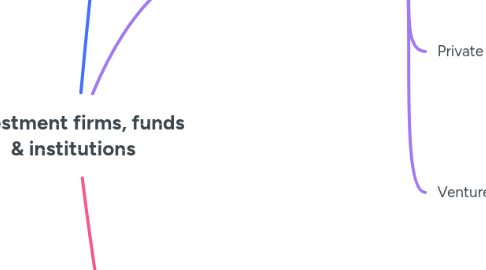
1. Investment Firms
1.1. Brokerage Firms
1.1.1. • Help people buy and sell securities like stocks and bonds. • Earn from commissions or fees per trade.
1.1.1.1. Operate as middlemen. Clients place buy/sell orders. They earn commissions or from order flow. Example: TD Ameritrade – You buy Apple shares via app, and they earn via spread or fees.
1.1.1.1.1. They generate revenue through: • Trading commissions (though many are now $0) • Spreads (buy/sell price differences) • Margin lending (interest on borrowed funds) • Payment for order flow (sending orders to specific market makers).
1.2. Asset Management Firms
1.2.1. Manage portfolios for clients such as individuals or institutions. • Earn a percentage of assets under management (e.g., 1% per year).
1.2.1.1. Manage money on behalf of clients. Invest in diversified portfolios and charge % of AUM. Example: BlackRock – Runs iShares ETFs. Charges small annual fees and manages billions.
1.2.1.1.1. Revenue model: • Management fee as a percentage of assets under management (AUM) • Sometimes performance fees (especially for institutional or alternative strategies).
1.3. Investment Banks
1.3.1. Help large companies raise capital, do mergers, or go public. • Earn fees from deals, underwriting, and trading.
1.3.1.1. Advise on IPOs, mergers, and raise capital. Earn underwriting and advisory fees. Example: Goldman Sachs – Helped Facebook IPO, earning millions in fees.
1.3.1.1.1. Divisions include: • Corporate Finance – Advising on deals • Sales & Trading – Executing large trades • Research – Publishing investment analysis
2. Investment Funds
2.1. Mutual Funds
2.1.1. • Pool money to invest in diversified assets. • Used by everyday investors. • Managed actively or passively. • Charge 1%–2% management fees.
2.1.1.1. Pool investors' money and invest in diversified assets. NAV changes daily. Example: Fidelity Blue Chip Fund – Invests in top growth stocks, charges ~1% fee.
2.1.1.1.1. Revenue: • Management fees • Sometimes sales loads or redemption fees Types: • Equity, Bond, Balanced, Sectoral, Index Funds.
2.2. Exchange-Traded Funds (ETFs)
2.2.1. • Like mutual funds but trade like stocks. • Mostly passive. • Lower fees (0.1%–0.5%).
2.2.1.1. Track an index and trade like stocks. Lower fees than mutual funds. Example: SPDR S&P 500 ETF – Buys top 500 US stocks, charges ~0.09% fee.
2.2.1.1.1. Revenue: • Low expense ratio • Bid-ask spread.
2.3. Hedge Funds
2.3.1. • Use aggressive strategies. • For wealthy investors. • High risk and high return. • Charge 2% of AUM + 20% of profits.
2.3.1.1. Use complex, high-risk strategies. Only for rich or institutional investors. Example: Bridgewater – Uses macro strategies and shorting, manages billions.
2.3.1.1.1. Fee structure: • '2 and 20' – 2% AUM + 20% of profits • Often have lock-up periods.
2.4. Private Equity Funds
2.4.1. • Invest in private companies or buy public ones. • For long-term profit through improvement and resale.
2.4.1.1. Buy companies, improve them, then sell for profit. Long-term focus. Example: KKR – Bought a factory, improved it, sold years later for profit.
2.4.1.1.1. Stages: • Fundraising from institutions • Sourcing deals • Managing portfolio companies • Exiting via IPO or sale Returns are distributed back to investors after exits.
2.5. Venture Capital Funds
2.5.1. • Invest in early-stage startups. • Very high risk and potential reward. • Focus on innovation.
2.5.1.1. Invest in early-stage startups with high risk. Hope for big returns from a few successes. Example: Sequoia Capital – Invested in WhatsApp, made billions from Facebook acquisition.
2.5.1.1.1. Stages: • Seed funding • Series A, B, C, etc. • Exit through IPO or acquisition VCs hold board seats and influence company strategy
3. Investment Institutions
3.1. Commercial Banks
3.1.1. • Offer savings and loans. • Also invest depositors’ money conservatively.
3.1.1.1. Accept deposits and lend out money. Profit from interest spread. Example: HSBC – Uses deposits to issue loans and invest in bonds.
3.1.1.1.1. Revenue: • Net interest margin (interest income - interest paid) • Fees for services (ATM, overdraft, advisory). They are regulated for capital adequacy and risk management.
3.2. Insurance Companies
3.2.1. • Invest premiums to cover future claims. • Long-term and conservative investors.
3.2.1.1. Invest premiums to ensure they can pay future claims. Example: Prudential – Invests in bonds and real estate for stable long-term returns.
3.2.1.1.1. Types: • Life, health, property & casualty insurance Revenue: • Underwriting profits • Investment income (main source) Assets include bonds, mortgage securities, and real estate.
3.3. Pension Funds
3.3.1. • Manage retirement savings. • Very long-term horizon.
3.3.1.1. Invest retirement savings. Aim for steady growth over decades. Example: CalPERS – Manages $400B in stocks, infrastructure, and real estate.
3.3.1.1.1. They allocate across stocks, bonds, infrastructure, and alternatives. Examples include government pension plans and corporate retirement schemes.
3.4. Sovereign Wealth Funds
3.4.1. • Government-owned. • Invest national surplus, e.g., oil profits. • Very large and strategic.
3.4.1.1. Invest national savings or resource income globally. Example: Norway GP Fund – Invests oil money in 9,000+ companies worldwide.
3.4.1.1.1. Assets: • Equities, bonds, infrastructure, private equity Goals: • Preserve wealth for future generations • Stabilize economy • Political influence
3.5. Endowments & Foundations
3.5.1. • Manage money to support non-profit missions. • Invest for stable income.
3.5.1.1. Invest donations and use part of returns to fund missions. Example: Harvard Endowment – $50B fund supports university programs.
3.5.1.1.1. Revenue: • Donations • Investment returns Spending rule: • Typically 4–5% of endowment used yearly for operations or grants.
